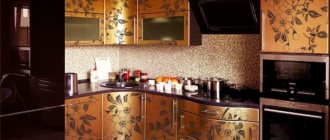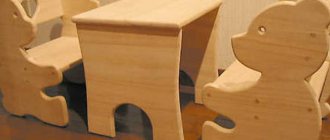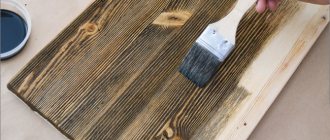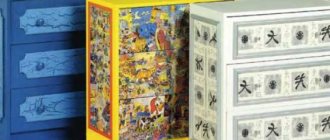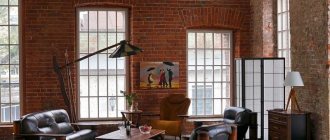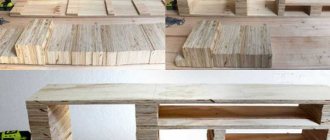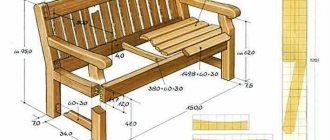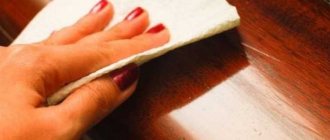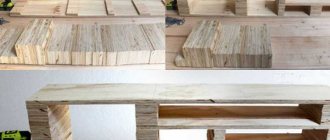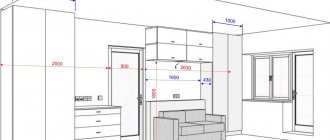0
10508
Wicker furniture is considered an excellent solution for different interiors and exteriors. It has many advantages and is presented in numerous forms; you can create wicker furniture with your own hands quickly and easily, and at the same time it can fully meet the needs of direct users. The whole process is divided into simple sequential steps, so if you first make a drawing, watch a training video and follow the instructions exactly, you will get a reliable and durable design.
The benefits of making furniture with your own hands
Made with your own hands, such furniture has advantages and certain disadvantages. Among the undeniable advantages:
- light weight, allowing you to move it to any place in the room or area of the site;
- does not require special care: it looks elegant and fresh, if you periodically wipe it with a damp cloth or sponge, this simple procedure protects the product from cracking;
- fits perfectly into any interior, adding lightness and sophistication;
- environmentally friendly, not emitting substances harmful to health into the surrounding atmosphere;
- when weaving is done correctly, it is durable and strong;
- complete freedom of imagination for home craftsmen;
- will significantly save the family budget;
- the opportunity to acquire skills that allow you to organize your own small profitable business.
Made with your own hands, such furniture has advantages and certain disadvantages.
Despite the undoubted advantages of wicker furniture, there are also disadvantages that must be taken into account:
- afraid of high humidity: cannot be left outdoors in bad weather;
- At the same time, the scorching sun will also not do any good: the furniture will dry out, warp, and lose its appearance, which will lead to a reduction in service life.
Light weight, allowing you to move it to any place in the room or area of the site.
Advantages and disadvantages
The advantages of creating wicker furniture include:
- low costs for obtaining unique designs that are original;
- environmental friendliness, due to the fact that wicker furniture is made exclusively from safe and natural materials that do not cause any harm to people or the environment;
- the lightness of the resulting products, so they can be easily transferred from one place to another;
- the technology for making wicker furniture is considered not too complicated if you carefully understand it, so this process is accessible to every person;
- the structures do not have any unpleasant or specific odor;
- they are easy to care for, and this does not require the use of unusual care products, but it is not allowed to leave them outdoors for a long time, as they will lose their attractiveness and high parameters under the influence of ultraviolet radiation or rain;
- since it is planned to make wicker furniture with your own hands, unique designs can be obtained that cannot be found in stores;
- The long service life of the structures makes it possible not to think about buying new furniture for many years.
To learn how to competently weave different designs, it is recommended to practice first, for which you can create different products for dolls or other toys.
The disadvantages of DIY wicker furniture include the fact that it does not withstand exposure to various atmospheric factors for a long time, so it is not allowed to leave it outside for a long time. Also, regular use leads to the fact that some elements of such products will begin to unravel, and repair is a complex process.
Deciding on design and construction
Structurally, wicker furniture can be:
- frameless,
- frame.
Fits perfectly into any interior, adding lightness and sophistication.
For a frameless structure, it is enough to use sticks. They perform the function of hard ribs. The difference between frame products is the presence of a metal base; steel rods are used for it. The weaving seems to be “attached” to them. Wooden poles provide stability and rigidity to the wooden structure.
Does not require special care: it looks elegant and fresh if you periodically wipe it with a damp cloth or sponge.
If home craftsmen are taking their first steps in weaving furniture, they should not take on complex products: it will be extremely difficult for an inexperienced craftsman to complete them, which will lead to numerous mistakes and disappointments; you need to start with the simplest ones, which give you the opportunity to master the necessary skills.
In order for the product to be of high quality and durable, you need to properly prepare the raw materials.
The furniture has several types of weaving:
| Type of weaving | Distinctive features |
| Single | Simple weaving is easy to master: each branch alternately braids all the posts of the frame. Usually used as the main method of making wicker items. Gives additional strength and keeps the shape of the product. |
| Openwork | Weaving is used in furniture decoration, adding special chic and originality. It can be used to create waves, corners, ovals, crosses, and diamonds. Requires perseverance, attention, accuracy. Before execution, you need to decide on the ornament, weave several single rows, then choose a decoration method. The most commonly used is straight openwork with stripes of light. A fairly complex type of work that requires significant skills. |
| Combined | This type is a combination of single and openwork weaving in their varieties. The design of wicker products using combined weaving is “aerobatics” and indicates a high level of craftsmanship. |
Environmentally friendly, does not emit substances harmful to health into the surrounding atmosphere.
How to do it yourself
Artificial rattan is easy to work with because it is flexible and is produced in the form of long threads, so it does not require gluing or joining of elements.
The choice of artificial rattan configuration is quite wide:
- long stripes;
- braid;
- rod;
- imitation of wooden bark.
The material can be of different lengths, thicknesses and widths. Artificial rattan is produced with a smooth and ribbed surface; it is varied in color and texture.
For weaving you will need a small number of tools:
- stapler - for attaching rattan to a wooden base;
- small pliers;
- medium sized hammer;
- cutter or large knife;
- a soldering iron for fastening structural elements or suitable glue.
Don't forget about the tool for creating furniture
Execution technique
In order to make a stable structure with a long service life, it is better to use ready-made furniture frames. They can be made of metal, wood, polypropylene. There are several advantages to braiding a finished base:
- economical consumption of base material;
- the weaving process becomes faster and easier;
- the design gains additional strength and stability;
- the service life of the product increases.
There are several basic weaving options:
- Simple. Single rods are woven between the posts. Each element alternates in front or behind the braided base.
- Rope. Each rack is surrounded by two rods on both sides.
- Checkers. The main rod (or several) braid 2 racks in a checkerboard pattern to the required height. This is how the first page is created. The second rod repeats the same, weaving between the rows of the first strip. The third and fourth stripes are woven in the same way.
- Chess. Complex weaving that creates shapes and openwork patterns with open cells.
- Pigtail. Used for weaving decorative elements and framing edges.
The most common rectangular shape (for example, a chair) is braided like this:
- First you need to build a wooden frame, which will consist of four legs and a frame.
- Reinforcing tourniquets should be attached to the top of the chair. For this purpose, we use the “braid” type of weaving. Connect the harnesses with a stapler and secure with self-tapping screws to give the structure additional strength.
- For braiding, the best option is checkerboard weaving. The rattan tape must be laid in one direction so that two short pieces and one long piece alternate. We fix short lengths on the seat with a stapler, and long ones on the crossbar.
- After the first layer of material is prepared, the tape is woven into it. We continue alternating one long and two short segments. You can use ribbons. Each new strip should be woven with a shift of one element to the left.
- The remaining ends must be secured and the remaining tape trimmed.
- To decorate the side elements, take a longer piece of ribbon and braid the side parts in a circle. If the tape runs out, it can be extended with a new piece using a soldering iron.
- The product should be braided to the very bottom in a circle. We bend the remaining ends inward and cut off the excess.
This weaving sequence is universal - it is also suitable for making a small ottoman, and if you increase the area of the frame, you will get an excellent coffee table.
Decoration
Options for decorating furniture are very diverse: bright textiles, pillows, rugs.
The advantages of artificial rattan furniture are obvious:
- budget savings;
- long service life;
- lightness and mobility of wicker products;
- strength and reliability;
- resistance to moisture and sun;
- environmental friendliness;
- easy care.
If you master the technology of weaving from natural or artificial materials, you can decorate your home, apartment, or summer cottage with stylish original furniture and interior items at no extra cost. It is not difficult to make artificial rattan furniture with your own hands; the prepared frame is braided with rattan cord or ribbons, and a pattern is created according to the chosen pattern.
Necessary materials
To make furniture from wicker you will need materials. It is worth noting that they can be different, and many are exotic and inaccessible to us: banana leaves, bamboo, water hyacinth, seaweed. But most of the furniture is made from rattan, willow twigs, bird cherry vines, alder, raspberry, and hazel.
Experts say that it is possible to harvest raw materials in the spring.
IMPORTANT! If you decide to use a vine, willow and bird cherry, which are particularly flexible and plastic, are best suited. Bird cherry is especially good in this regard.
When weaving correctly, it is durable and strong.
Excellent decorative elements are colored pillows and blankets of various colors.
Features of organizing a business for the production of wicker furniture
Legal form of business
For legal registration, it is enough to register an individual entrepreneur, because the end consumer is mainly individuals.
Official activity
To conduct business activities, you must indicate the following OKVED codes:
- 36.14 – Production of other furniture;
- 52.44.1 Retail sale of furniture.
Room
In a workshop for the production of wicker furniture it is necessary to provide:
- a room for drying vines (outside - in the warm season, in a well-heated drying room - in winter);
- room for painting and varnishing;
- main production workshop.
There are no special requirements for the premises: heating, communications, access roads.
State standards
To get started, familiarize yourself with GOSTs:
- 25552-82 — Twisted and wicker products. Test methods
- 13025.5-71 Household furniture. Functional dimensions of tables
- 13025.2-85 Functional dimensions of furniture for sitting and lying
- 19120-93 Furniture for sitting and lying. Sofa beds, sofas, chair beds, lounge chairs, couches, ottomans, benches, banquettes. Test methods
Increasing benefits
The production of wicker furniture is a highly profitable business, especially if you procure the raw materials yourself. A finished furniture rod costs about 150-200 rubles/100 pieces (depending on the thickness and category).
Financial indicators
The cost of a finished wicker chair made according to GOST standards and sizes is 1-1.5 thousand rubles. (includes labor costs and purchased materials). At the same time, the sales price of the product starts from 3,000 rubles. and higher (depending on the region).
It takes about 3-5 days to make a chair or stool by one craftsman (depending on the complexity of the weaving).
Preparation of raw materials for robots
In order for the product to be of high quality and durable, you need to properly prepare the raw materials. Most often these are willow twigs.
- For weaving, you can harvest material that is collected from living trees in the absence of buds; the most suitable time for harvesting is late autumn. You need to make it before the first frost - such raw materials are easy to clean and store dry.
- Experts say that you can prepare raw materials in the spring, but you need to remember that you need to cut the rods before the buds begin to swell; if you are late, green leaves will appear on the new furniture.
- You need to cut the branches at forty degrees - pruning will not harm the tree, and in a year or two new branches will appear.
- You need to conduct a kind of flexibility test. The cut branch must be bent: if it does not break, then the raw material is suitable for the job. Thin vine used for fine binding of products is considered to be of high quality.
- Thicker branches are used to make the frame.
The opportunity to acquire skills that allow you to organize your own small profitable business.
How to weave furniture from twigs: step-by-step instructions
A step-by-step description of the process of weaving furniture is a good help for people just starting to master this type of needlework.
How to weave a chair from willow or rattan
First of all, we need a chair frame. It is made from sticks, the thickness of which varies between 15–20 mm. The frame can be reinforced with plates, rods or weaving.
Ready-made wooden frames are also available for sale.
The use of a ready-made wooden frame will significantly simplify and speed up the work
The weaving process itself takes place in several stages:
- Fastening to the frame of the racks. For this, rods with a thickness of 15–20 mm are used.
- Continuous weaving of the chair seat with rods about 10 mm thick.
- Back weave. Here you can use a continuous method, or you can experiment with openwork weaving.
- Finishing of the product - painting and cleaning. Excess rods and ends remaining during weaving are cut off, and the density of the weaving is leveled. If necessary, the product is painted in the desired color or bleached.
The chair can be made on a ready-made frame.
A chair can be woven like a chair, only armrests are added to it.
Video: DIY chair weaving
Required Tools
To weave furniture from wicker, you don’t need many tools, but you should have:
- knives and pruners;
- tape measure and measuring tape;
- various templates.
Afraid of high humidity: should not be left outdoors in bad weather.
We must not forget about the armrests, which, however, are made at the request of the master, but serve as an additional element to strengthen the entire structure.
This is the required minimum; with the help of such a set of tools you can weave simple and small-sized products.
The difference between frame products is the presence of a metal base; steel rods are used for it.
Equipment for the production of wicker furniture
Depending on the complexity of the technological process, hand tools and machines are used in the production of wicker furniture. The braider's workplace is a stable table 750 mm long, up to 65 0 mm high and 400-450 mm wide with drawers for storing tools.
Manual equipment for mechanical processing of furniture includes:
- hand saws;
- shmol (for sharpening ribbons to width);
- plows;
- clamps (steel plates for bending or straightening rods);
- bit;
- iser (a cone-shaped steel plate for aligning rows in products and thickening the weave);
- chisels;
- drills, drill bits;
- screwdrivers;
- emery skins;
- knives and other tools.
As for automated production , this does not exist at the moment. There are only machines whose prototype was weaving (Loom-technologies), but for natural raw materials such technologies were not justified in terms of quality: even weaving a simple fabric after stitching is prone to deformation, and precise fitting of the frame with uniform tension of the braid along the entire length is possible can only be achieved manually.
Manufacturing process: technology and manufacturing nuances
In order not to lose interest in weaving furniture and not to spoil a large amount of material, you should not immediately “swing” at large and quite complex products - a sofa or a table. It’s better to start with the simplest “braids”, for example, a chair. It consists of several elements: a lower bench, a seat, a backrest, and armrests. To work, you will need willow sticks with a diameter of up to 30 mm and thin willow twigs.
Wooden poles provide stability and rigidity to the wooden structure.
The beginning of the work is the manufacture of the frame.
ADVICE. When working on a chair, you will need curved parts. To bend the rods, you need to soak them, and when they become soft, remove any irregularities and bend them on a prepared template and let them dry.
You need to cut the branches at forty degrees - pruning will not harm the tree, and in a year or two new branches will appear.
The beginning of the work is the manufacture of the frame. If a craftsman is taking his first steps in weaving furniture, it is better to use the frame of an old chair made of metal or wood to make the work easier.
You need to conduct a kind of flexibility test.
When working on a chair, you will need curved parts.
ATTENTION! We must not forget about the armrests, which, however, are made at the request of the master, but serve as an additional element to strengthen the entire structure.
But most of the furniture is made from rattan, willow twigs, bird cherry vines, alder, raspberry, and hazel.
The procedure for making a chair.
- We make the frame. The frame itself is made of thick, durable sticks and a piece of plywood, which is used as a seat. One pair of sticks will act as the front legs; it should be 15-20 cm shorter than the second.
- The legs are connected with self-tapping screws, the seat is nailed down.
- Also, the curved elements of the chair back and armrests are attached to the frame with self-tapping screws.
- The frame is wrapped with willow ribbons and can be secured with glue for strength.
- The frame is braided using single weaving.
Bird cherry is especially good in this regard.
It’s better to start with the simplest “braids”, for example, a chair.
If desired, the resulting chair is treated with stain.
To make furniture from wicker you will need materials.
Benefits of rattan weaving
Before you start weaving a rattan chair, you need to imagine what it will be like. You can make a frame or take a simple chair and then braid it with rattan. This is the simplest option. Experienced craftsmen can weave a chair entirely from rattan.
You can find weaving patterns online and study them carefully. There are several main types, but they are also divided into subspecies:
- Continuous dense weaving - can be simple, rope and checkerboard.
- Openwork - divided into checkerboard, rosette, ring and spiral.
- Pigtail - this is how decorative elements and edges are decorated.
- Folding - these types of woven edges.
To begin with, it is better to take artificial rattan, which does not require preliminary preparation for weaving, and weave it around the frame of the chair. It is made from strong boards: a stool on four legs with a backrest is knocked together. The surface can be left untreated, since it will still not be visible under the weaving.
The final stage is decoration
High-quality wicker furniture practically does not need decoration: it is good in itself. If you want to add an element of creativity and “revive” it with bright colors, you can use willow ribbons in weaving, including dyed ones; they will be organically combined in the ornament of the product. Excellent decorative elements are colored pillows and blankets of various colors.
If home craftsmen are taking their first steps in weaving furniture, they should not take on complex products.
Thicker branches are used to make the frame.
Life history of wicker furniture
Weaving furniture is a fascinating and rewarding process. Making an effort and weaving extraordinary and functional interior items is accessible to every person who loves creativity and does not know how to be lazy.
You can purchase ready-made wicker furniture for your cottage and garden at low prices from the Kupistol company.
This is what a bed woven in ancient Egypt looked like
The spread and popularization of this type of needlework in Russia was facilitated by the location of villages near reservoirs, where the main types of natural material for weaving grew. True masters of their craft lived and worked in different provinces. The Moscow, Nizhny Novgorod, Kostroma, Ivanovo, Vladimir, and Yaroslavl regions were famous for such products.
Archaeologists find wickerwork in various parts of the world - Egypt, the Middle East, Europe. Items made of wicker, willow, rattan, reed, papyrus and other suitable materials have always been in demand in everyday life: baskets, laundry boxes, strollers, fishing tools, vases.
Gradually, wickerwork from ordinary homes migrated to the interiors of wealthy people, becoming beautiful, elegant furniture. Many wicker products were in demand by the Russian nobility in the 20th century. They began to be produced not only by single artisans, but also by entire artels, whose participants studied in specially opened weaving schools.
In the houses of aristocrats, entire sets were made of wicker
The passion for wicker furniture came from Prince Golitsyn, who, having seen similar products abroad, introduced this type of applied creativity to his estate, creating a specialized workshop.
Masters of this type of needlework wove:
- furniture (couches, sofas, chairs, tables, chaise lounges, armchairs, rocking chairs, cradles, screens, shelves);
- travel accessories (suitcases, suitcases, bags, chests);
- household items (baskets of different sizes, vases, bread bins, plates, candy bowls);
- toys (rattles, cars, dishes and furniture for dolls).
Hanging furniture was also made from wicker.
Most often, furniture is woven from rattan, wicker and willow.
Nowadays, this craft is also not forgotten. Wicker furniture can be purchased in specialized stores or from craftsmen. But you can test yourself, try your hand at this type of applied art. By making furniture from wicker for a summer house, country house or loggia, you can become the owner of a unique interior element.
Wickerwork can be seen on the canvases of world-famous artists: a cradle in Rembrandt’s painting “The Holy Family”, baskets in Pieter Bruegel the Elder’s “Haymaking”, a basket in the hands of a maid depicted by Pieter de Hooch (“Mistress and Maid”), household items in Jan’s painting Vermeer's "Thrush" and others.
Peculiarities
Wicker furniture has been known to man for a very long time. But recently its popularity has increased sharply. It began to be used almost everywhere - from home to large restaurants. Several significant advantages of such products should be highlighted:
- Environmental friendliness. This applies to almost all types of such structures, since the materials used in their manufacture do not emit harmful substances into the external environment. But you should understand that if the chair is painted, then this may be one of the ways to doubt its high quality.
- Durability. The service life of such a chair exceeds 5 years. But these parameters depend only on the material used and production technology.
- Strength. Almost all types of chairs can withstand significant loads. This can be said about both rattan and natural wicker. It should also be noted that it is highly resistant to moisture. The chairs can be used both indoors and outdoors (terraces, balconies, etc.).
- Easy to care for. To ensure that the chair retains its beautiful appearance for as long as possible, you should periodically wipe it with a slightly damp cloth and remove dust. This will increase the service life by several years.
- Light weight.
